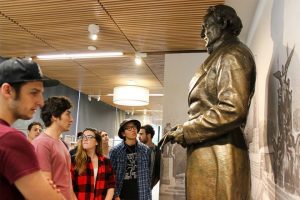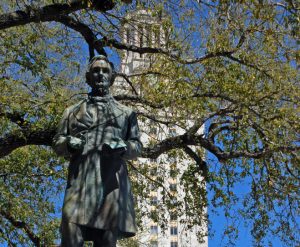
I spent a couple of days this week researching in the manuscript holdings of the Briscoe Center for American History at the University of Texas. In addition to its manuscript collection, the Briscoe Center includes a 4,000-square-foot museum of American history, and the most striking exhibit in that museum is a nine-foot-tall statue of Confederate president Jefferson Davis. There’s a story behind that exhibit, and it illustrates the right way to deal with monuments to Confederate leaders.
Around 1920, Texas rancher, banker, and Confederate veteran George Littlefield commissioned Italian sculptor Pompeo Coppini to create the one-ton bronze likeness of the Confederacy’s only president. Cast in Brooklyn in 1924 and shipped to Texas, the statue was displayed first in an Austin bank and then at the Texas capitol before being moved to a perch high on a limestone plinth on the main mall of the University of Texas, where it remained for more than 80 years.

It’s safe to assume Davis’s bronze likeness was not given that lofty place in recognition of his efforts, while serving as U.S. secretary of war during the 1850s, to introduce camels into U.S. Army cavalry regiments. Obviously it was because he was president of the Confederacy. But during the statue’s first half century on the mall, most people seemed not to think about it very much. Perhaps Confederate monuments are tolerable precisely until any significant number of people start thinking seriously about them.
The civil rights movement did stimulate serious thought about such things, and people began to call for the statue’s removal. For 25 years such calls became more numerous, but the statue stayed where it was. Then in 2015 University of Texas student government voted almost unanimously for the statue’s removal, and an advisory board appointed by the university’s president supported the demand. So that year the statue was removed from the mall and, after being refurbished, it was displayed in the also newly refurbished exhibit space of the Briscoe Center. The new exhibit is educational and properly respectful without giving honor to a man whose best known activity in life put him on the wrong side of truth, justice, and the U.S. Constitution.
As someone who has written two books on Jefferson Davis, and thus spent a good part of eight years reading his mail–as well as his exceedingly stuffy two-volume memoir–I feel almost as if I had known the man. It was good to see him there–in a museum–where he belongs.
The way the University of Texas has treated this matter is an example for the rest of the nation to follow. A public monument that sent a wrong message–a message of racism, slavery, and unjustified rebellion–was removed from a position of honor. It will no longer send the silent message to university students and visitors that those causes are worthy of emulation. This was done not through the intervention of any outside authority, but rather by the action of the people who either owned or lived with the monument–the president, advisory board, and students of the university. It was done in a peaceful, orderly, and lawful way, and not by a mob. It was done in a decent and respectful way, because good people show respect to a vanquished foe, even though his cause was wrong. The statue was preserved as a work of art, and history was not “erased” but rather made more accurate and accessible.
Related